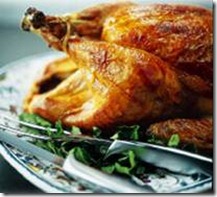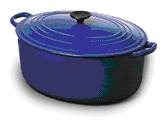Here is my original Turkey and Gravy recipe, from November 13, 2003.
 I made this recipe for Thanksgiving a couple years ago when we had our friends Mandi and Phil over; it was far and away the best turkey any of us had ever tasted. I dream about this turkey. I reached a state of ecstasy eating leftovers for days. Especially with the gravy. Absolutely worth all the effort, which is not insubstantial, especially for the gravy. John Speare taught me everything I know about making turkey and gravy. His source material came from Cook’s Illustrated magazine. I have a photocopy of their giblet pan gravy recipe that I’ve used the last couple of years, which is largely reproduced here.
I made this recipe for Thanksgiving a couple years ago when we had our friends Mandi and Phil over; it was far and away the best turkey any of us had ever tasted. I dream about this turkey. I reached a state of ecstasy eating leftovers for days. Especially with the gravy. Absolutely worth all the effort, which is not insubstantial, especially for the gravy. John Speare taught me everything I know about making turkey and gravy. His source material came from Cook’s Illustrated magazine. I have a photocopy of their giblet pan gravy recipe that I’ve used the last couple of years, which is largely reproduced here.
Step 1 Making Stock
You’ll need 6 cups or so of turkey stock for the gravy, so this is the place to start. The key is to do this ahead of time; you don’t want to be trying to make turkey stock the night before Thanksgiving or anything, although I’ve done it. Having a couple quarts of homemade stock all ready to go makes a huge difference. Homemade stock, when done right, is amazing stuff. You can use it for sauces, soups, gravies, etc. It’s extremely versatile, and can easily be frozen for later use.
6-8 turkey necks (you can also supplement the necks with turkey wings)
1 small onion, roughly chopped
1 rib celery, roughly chopped
1 carrot, roughly chopped
6 parsley sprigs
2 Tbs vegetable oil
Dry vermouth
I get my turkey necks from Larry’s Market. I don’t normally use wings, but they’re supposed to work well.
1. Chop up the necks into 2 inch pieces with a cleaver.
 2. Heat the oil in a Dutch oven on the stove over medium-high heat. You need a lot of surface area to brown the necks, so an oval variety such as a Le Creuset 6 ½ qt variety is ideal.
2. Heat the oil in a Dutch oven on the stove over medium-high heat. You need a lot of surface area to brown the necks, so an oval variety such as a Le Creuset 6 ½ qt variety is ideal.
3. Once the oil is good and hot, add the first batch of necks in a single layer to the pan. Every piece needs to be in contact with the bottom of the pan. Be careful not to overfill.
4. Brown the necks on all sides. The pan should be very hot, oil should spatter, and the necks should get a good brown crust. The bottom of the pan should get a bunch of brown stuff sticking to it (fond); this is the key to good stock. Periodically scrape the fond off the bottom with a wooden spatula.
5. Once the necks have been browned on all sides, dump them out on a plate. Add a bit more oil to the pan and brown the next batch. Keep doing this until all the necks are browned and on the plate.
6. Put the empty pan back on the burner and make sure it’s hot. Pour in some vermouth (about ¼ cup) to deglaze and vigorously scrape up the fond on the bottom.
7. Throw in the carrots, celery, and onions (or leave out the onions for Mike-friendly stock). Cover with a lid and turn the heat down to low. Let simmer for 20 minutes until the onions have leached out their juices.
8. Add the turkey necks back into the pan and fill with water until the necks are covered by about an inch of water.
9. Add the parsley sprigs. You can also throw in a bay leaf, some peppercorns, thyme sprigs, or other herbs to give a bit of extra flavor.
10. Simmer for a couple hours.
11. Strain with a colander into a mixing bowl. Restrain with a mesh strainer if you want to get all the bits out.
12. Refrigerate overnight. The next morning skim off the layer of fat floating on the surface. Pour the stock (if you did a good job it should be somewhat gelatinous) into a Tupperware or other container. You can freeze whatever you don’t use for the gravy up to about 3 months.
Step 2 Brining the Turkey
3 cups kosher salt
1 cup sugar
Bucket with lid
2 gallons water
12-14 lb fresh turkey
Brining is essential to getting a juicy turkey that’s cooked all the way through but without the breast being dry. It does wonders. You’ll never go back after trying it. The timing is a bit tricky because you want to give the bird time to air-dry after soaking in the brine, which helps contribute to a nice crispy brown skin.
Make sure to get a small, fresh turkey that hasn’t been frozen. 15 pounds is the absolute limit. 12-14 is ideal. It’s more than enough turkey and the results will be very superior. A couple warnings: make sure you don’t get a kosher bird, which will already have been soaked in a salt solution. Also make sure you don’t accidentally wind up with one of those hideous self-basting turkeys with the built-in thermometer that have been injected with “fat, broth, and ‘flavor-enhancers’” as I believe the bird I wound up with last year said.
1. You need a bucket or other container with a lid that will hold the turkey. It shouldn’t be so big that the turkey can turn while it’s brining. A big stock pot would also work well. I’ve used empty buckets from Nagoya Teriyaki that soy sauce comes in.
2. The morning of the day before Thanksgiving, fill the bucket with 2 gallons of water. Add the salt and sugar and stir until thoroughly dissolved.
3. Rinse the turkey, remove the neck and giblets from the body cavity and set aside for the gravy. Put the turkey in the bucket and pop on the lid. Put the bucket in the refrigerator or outside; the temperature needs to be no warmer than 40 degrees.
4. The evening before Thanksgiving, after the turkey’s been in the brine for at least 8 hours, remove it from the brine and rinse it very thoroughly for a couple minutes under cold water, inside and out. Pat it dry with paper towels inside and out, then put it on a rack over a cookie sheet in the refrigerator. Let air dry overnight.
Step 3 Making the Gravy Base
1 Tbs vegetable oil
Reserved giblets and neck
1 small yellow onion, roughly chopped
11/2 quarts turkey stock
2 thyme branches
8 parsley stems
The night before Thanksgiving, while the turkey is brining or drying, make the base for the gravy. Despite any misgivings you might have about the giblets, they really do add some good flavor.
1. Use a cleaver to hack the turkey neck into 2-inch pieces.
2. Heat the oil in a pot over medium heat; sauté the giblets and neck pieces until golden brown, about 5 minutes.
3. Add the onion and sauté another 5 minutes.
4. Reduce heat to low, cover, and cook until the turkey and onion have released their juices, about 20 minutes.
5. Add the stock, thyme, and parsley. Bring to a boil, then turn heat to low. Simmer uncovered for 30 minutes or so, skimming off any scum that rises to the surface.
6. Strain broth through a colander into a bowl. Restrain through a mesh strainer.
7. Discard giblets and necks. If you want the truly classic “giblet pan gravy” then you should actually dice up the giblets, shred the neck meat, and throw these in the gravy at the end. However I just use these for flavor. I haven’t yet convinced Kim that a chunk of turkey heart floating in her gravy is good eating.
8. Store the base in a Tupperware or other container in the refrigerator until needed for the gravy on Thanksgiving.
Step 4 Roasting the Turkey
1 medium yellow onion, roughly chopped
1 ½ medium carrots, roughly chopped
1 ½ celery stalks, roughly chopped
6 thyme sprigs
3 Tbs unsalted butter, melted
1 cup water
Large roasting pan
V-rack
Turkey baster
The perennial problem with roasting a turkey is that by the time the dark meat is cooked, the breast is dried out. Brining goes a long way to alleviating this problem, but the other key is to not have the breast directly exposed to the heat the entire time. In an oven the heat circulates around and rises, being hottest near the top. So you start with the breast down, then flip the turkey on its side, then the other side, and finally finish with the breast up. A v-rack makes it easy to roast the turkey on its sides and is a necessary piece of equipment if you don’t want to worry about the turkey crashing over during roasting.
1. Preheat over to 400 degrees and adjust oven rack to lowest position.
2. Toss one-third of onion, carrot, celery, and thyme with 1 tablespoon of melted butter and place this mixture in body cavity.
3. Truss the turkey: bring turkey legs together and tie with kitchen twine. Tie another piece around the turkey, pinning the wings against the body.
4. Scatter the rest of the vegetables and thyme in the roasting pan. Pour in the cup of water.
5. Rub the v-rack with vegetable oil and place in the pan. Brush the turkey breast with 1 Tbs of the butter, then place the turkey breast-side down on the v-rack. Brush the underside of the turkey with the remaining butter.
6. Roast for 45 minutes. Remove pan from oven quickly, making sure to let out as little heat as possible. Baste the turkey with juices from pan. Using potholders or paper towels, flip the turkey carefully onto its side, being careful not to tear the skin. If liquid in pan has totally evaporated, add another 1/2 cup water.
7. Return turkey to oven and roast another 20 minutes. Repeat as before, basting the turkey and flipping onto the other side.
8. Roast for another 20 minutes. Remove turkey from oven a final time, baste, and turn it breast side up. Add more liquid to the pan if necessary.
9. Roast until breast registers about 165 degrees and thigh registers 170 to 175 degrees, 30 to 45 minutes longer. I like to use a digital thermometer with a long wire attached to a probe that plugs into the readout base. This lets you keep the thermometer in the turkey while it’s in the oven and be able to read the temperature outside the oven. Once the turkey is done (it’s much better to err on the side of over-cooked then undercooked!), remove turkey from pan and let rest on a cutting board until ready to carve (15 minutes is about right).
Step 5 Making the Gravy
3 tablespoons unsalted butter
1/4 cup flour
1 cup dry white wine (vermouth, Chardonnay, Sauvignon Blanc)
Salt and ground black pepper
Finishing up the gravy is a two-step process. The first step is to make the roux and add it to the gravy, which should be done while the turkey is roasting. Then while the turkey is resting, finish the gravy using the pan drippings.
1. While turkey is roasting, bring the reserved turkey base to a simmer.
2. Heat butter in large heavy-bottomed saucepan over medium-low heat. Vigorously whisk in the flour (roux will froth and then thin out again). Cook slowly, stirring constantly, until nutty brown and fragrant, 10 to 15 minutes. Vigorously whisk all but 1 cup of hot broth into roux. Bring to a boil, then simmer until gravy is thickened and very flavorful, about 30 minutes longer. Set aside until turkey is done.
3. While the turkey is resting, tilt the roasting pan so that the juices all run into one corner. Spoon off as much fat as possible. Don’t be afraid to spoon off too much fat, as you don’t want the gravy to be greasy.
4. Return gravy to simmer. Place the roasting pan over two burners on the stove and set the heat to medium-high. If the drippings are not already a dark brown, stir until they caramelize.
5. With the pan good and hot, pour in the wine to deglaze, vigorously scraping up the browned bits and caramelized vegetables and herbs with a wooden spoon. Bring to a boil and reduce by half, about 5 minutes. Add the remaining cup of broth, then strain the pan juices into the gravy, mashing the vegetables and herbs down to press out as much juice as possible. Discard the vegetables.
6. Bring the gravy to a boil and then reduce to a simmer. Taste and add salt and pepper as needed.
Step 6 Carving the Turkey
Fresh herbs for garnish
Very sharp non-serrated knife
Serving platter
Carving the turkey at the table is a nice moment of traditional culinary drama, but if you don’t like the time pressure, bring out the turkey for everyone to admire, then take it back into the kitchen and carve it, then return with the carved pieces on a platter, surrounded by a nice garnish of herbs (sage, rosemary, kumquats add some nice color). That’s the approach I take when roasting a chicken, although for Thanksgiving I usually carve tableside on a little side table. Serve the turkey on a warm platter so it doesn’t get cold. Just warm the serving platter in the oven for a few minutes before carving.
Serve with the gravy, mashed potatoes, yams, olives, cranberry sauce, and corn fritters.
